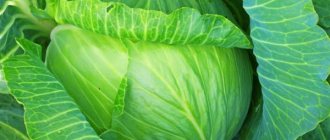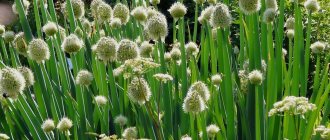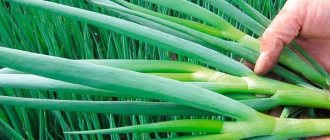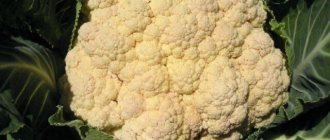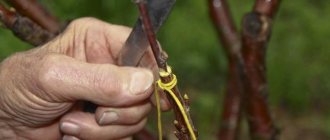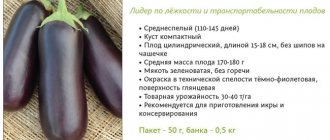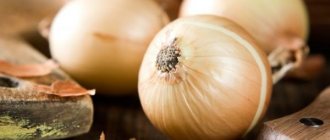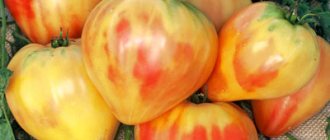Onion is a very rich and tasty variety that is grown for fresh salads. It does not produce heads and is valued exclusively for its juicy, delicate feathers. The Russian Winter variety is frost-resistant and can be grown for several years without replanting.
| Maturation | Type | Color | Life form | Taste |
| Average | Batun | Green | perennial | Mild-sharp |
Characteristics and description of the variety
Russian winter onion is recommended by experts for cultivation in all regions of the country; it easily adapts to any climatic conditions and is not susceptible to disease.
An application for its registration in the register was registered in 2000, and already in 2001 the variety was recognized as a selection achievement. Vegetable growers in the Odintsovo district of the Moscow region created it specifically for cultivation in vegetable gardens and small farms.
Russian winter batun is a salad variety. The ripening period is mid-season. That is, from the moment the leaves appear until the plant is technically ripe, about a month passes. The manufacturer uses a range of 27-30 days.
Externally, the plant looks like this: height up to 30-33 cm, diameter of the bush can reach almost a meter, 0.95 cm. The above-ground part is white with a faint yellow tint, the leaves are soft green. The taste is defined as mildly spicy.
Like other types of batun, Russian winter does not form a large, pronounced bulb. It is false, stem and bottom. The leaves are eaten: in salads, first courses and in their pure form.
The dry matter content, which is proteins, nitrogenous substances and carbohydrates, is minimal for this variety - 10.5% (onions according to the standard have 10-15% of such compounds). Total sugar reaches 4.3%, vitamin C – 55 mg per 100 grams of raw material.
Russian winter onions can be annual or perennial. In the first case, onions are sown with seeds in early spring in open ground and the plant is harvested in the fall. A perennial plant of this species can live and bear fruit in one place for up to 6 years, after which it needs to be renewed. If the bush has been growing for more than a year, you can cut it off completely two or three times over the summer.
Brief description of cultivation
- Sowing . Seeds for seedlings are sown in mid-April, and seedlings are planted in open soil in mid-June.
- Illumination . Shaded or sunny area.
- Soil . Neutral or slightly acidic, moist, nutritious loamy or sandy loam soil is well suited.
- Watering . It must be systematic and very plentiful. So, after watering, the soil should be saturated to a depth of about 0.2 m. If it rains systematically in the summer, then the bushes can be watered about 2 times every 7 days. However, during a long dry period, watering the site is carried out once every 2 days.
- Fertilizer . To do this, use organic matter, for example: wood ash, slurry or bird droppings solution. In this case, fertilizing with bird droppings is carried out only once, because this onion can accumulate nitrates.
- Reproduction . Seeds.
- Harmful insects . Onion flies, weevils and moths.
- Diseases . Downy mildew (downy mildew).
- Properties . It has high nutritional value and is used in dietary nutrition.
Onion - batun. Growing from seeds
Productivity
Russian winter is a high-yielding variety. For a one-time cutting from a bush, you can remove one and a half kilograms of greenery per square meter of area, for a season - three and a half kilograms.
It tolerates winter well at any level of snow cover. The first tender and thin leaves can be cut off as early as April, and the planted annual produces shoots for consumption within a month.
If the greens are dug up along with the onion, they can be stored for up to one and a half months without losing their presentation and high taste.
Planting dates and cultivation
Winter trumpet propagates both by seeds and by dividing the bush. The name of the variety is not accidental - indeed, its seeds can be sown before winter, in late autumn. The seeds also take root well in open ground from the 20th of April and throughout the following summer. It is preferable to divide the bush in the spring. As practice shows, the plant takes root better and has greater germination if it is propagated by seeds.
If onions are planted for one year, then the seeds are placed individually in holes 1-1.5 cm apart with a spread between plants of approximately 20 cm. If space for the harvest is allocated for several years in advance, it is better to sow this variety in nests, 4-1 in one hole. 5 seeds.
The uniqueness of the batun lies primarily in the fact that young, non-coarsened green arrows are used as food. You can get them either in early autumn from young shoots, or after cutting the bush. Renewal can also be achieved mechanically by planting seeds near the nest every couple of weeks.
Seeds remain viable for two to three years, then the percentage of germination decreases sharply.
Care after landing
Onion is a moisture-loving crop, so the soil should be moistened regularly.
As soon as the first feathers appear, the onion must:
- thin out the plant;
- treat with a growth stimulator;
- regularly, especially after rains, weed and loosen the soil;
- water moderately every other day;
- cut off onion feathers as soon as they grow more than 15 cm.
Since this is a perennial crop, it is necessary to remove old plants and plant new ones every year. Renewal is necessary to increase productivity.
Despite the fact that Tatarka retains its productivity for 10 years, it is recommended to renew the beds every 5 years.
The first year after planting, onions do not require intensive feeding; they can only be lightly sprinkled with ash.
Advice! In the first year, it is not recommended to cut off the leaves of the onion; this will help it survive the first winter well and get stronger.
Features of caring for the variety
Russian winter onions thrive on peaty and sandy soils. If there is a lack of mineral fertilizers in the ground, the plant withers and withers. The leaves become dry and more bitter.
Fertilize the soil for onions with humus at the rate of 5 kg per 2 square meter. It is also fed with potassium chloride (20 g/1 sq m), superphosphate (40 g/1 sq m) and ammonium nitrate (25 g/1 sq m).
In early spring, as soon as the first shoots of Russian winterweed appear, they should be covered with film. This will allow you to harvest an earlier, juicier and richer-tasting harvest. Watering under such conditions is best done with water at room temperature.
Watering for the variety requires medium intensity. Poor moisture will cause the leaves to dry out and increase their bitterness. Watering too frequently, and even more so water stagnation in the nests, will lead to rotting of the bulb and death of the plant.
The greenery of annuals, which will be removed at the end of the season, is completely cut off several times during the summer. If the onion is left in the garden for several years, the first time it is cut off in parts, especially in the second half of summer. An autumn cut will weaken the bulb, and it may not survive the winter cold.
After cutting, it is necessary to feed the bush with ash or rotted manure.
Blooming inflorescences are not left for the winter. They must be removed, otherwise harmful insects may settle there. Even without being dangerous for onions, they, however, will not become long-awaited guests for other crops in the garden in early spring.
The optimal temperature for harvesting is 20-25 degrees during the day and at least 13 degrees at night. Natural light must be available to the onion bush, otherwise the arrows will bend towards the sun's rays. A shaded place is not suitable for growing this variety.
Advantages and disadvantages
Among the advantages inherent in the Russian winter variety, the following should be highlighted:
- frost resistance;
- high productivity;
- early germination;
- not susceptible to disease;
- long preservation of presentation in the cut state.
Like most varieties of batun, the type we are considering has a number of disadvantages. But they, nevertheless, do not cover the advantages, which is confirmed by the growing popularity of Russian winter onions among gardeners. Disadvantages include:
- absence of a large independent bulb;
- rapid release of seeds from inflorescences;
- a relatively short period of growth of tender, not rough leaves.
Storage
There are several ways to store green crops. If you need to save the plant for the next lunch or the arrival of guests, a refrigerator is quite suitable. But for the winter, onions can be frozen, dried, salted and fermented.
Fresh
Onions placed in a plastic bag will keep in the refrigerator for about a month. Under no circumstances should you wash it before storing it in the cold. This procedure negatively affects shelf life.
This is interesting! To prevent moisture from forming on the walls of the bag, the greens should be cooled: place on the refrigerator shelf for 10 minutes. Then condensation will not form.
Dried
Rinse the cut leaves under running water and dry on a napkin. Cut into rings and dry in a shaded, well-ventilated place. You can also dry the cut leaves in the oven: set the temperature to 50 degrees and keep the baking sheet in it for a couple of hours. After this, the onions “reach” in the open air without direct sunlight for 8 hours.
Dried onions are stored in a fabric bag or birch bark container.
Salty
Here's how you can salt Russian winter onions: For half a kilo of greens we take 100 grams of salt. We wash the cut leaves, dry them on a cloth, then mix them with coarse table salt in a glass container. After compacting, place into glass jars. Pour a layer of sunflower oil on top and cover with a polyethylene lid.
This preparation is stored in the refrigerator or in the cellar.
Frozen
We wash the onion crop, dry it, and chop it finely. Again, give it about 20 minutes to dry. Place in bags and store in the freezer until next spring.
Sour
It is usually not the green leaves that ferment, but the bulbs and white stems that are adjacent to them. The Russian winter variety is good because its bulbs are relatively large compared to other types of batun. To prepare, you will need 0.5 kg of onion, bay leaf, 5 g of black peppercorns, half a liter of water and 50 g of salt.
Place washed, dried and chopped onions in a glass jar, add chopped bay leaves and onion peas. We dilute the salt in boiling water and pour the cooled solution into our mixture.
We put a weight on top and leave it for a week in the kitchen in a place where direct sunlight does not reach. After seven days, we put the semi-finished product in the refrigerator, where it is stored until spring.
Growing onion from seeds
Sowing seedlings
To ensure that you can definitely get a harvest of onion in the spring, it is recommended to grow it through seedlings. In eastern countries, this method of propagation is very popular, since in this case, in an annual crop, this plant is much less likely to get powdery mildew; in addition, thanks to the seedling method of cultivation, the ripening processes are accelerated.
Seeds are sown for seedlings in mid-April, and the plants are transplanted into open soil in mid-June. Harvesting of batun greens is carried out in early autumn along with false bulbs. To grow seedlings, use a substrate consisting of turf soil and humus (1:1). In 10 liters of the prepared soil mixture you need to add 70–75 grams of mineral fertilizer for garden plants, and another 0.4–0.5 liters of wood ash. Then everything needs to be mixed well. Next, the soil mixture is sterilized; for this, it is steamed in an oven or heated in a microwave; instead, it can simply be spilled with a dark pink solution of manganese potassium.
Before sowing, the seed material is placed in water for 24 hours, which should be replaced every 6 hours. Then they are placed on a refrigerator shelf intended for vegetables for 2-3 days. The removed seed must be dried to a free-flowing state, after which you can begin sowing. To do this, the box is filled with prepared soil mixture, in which shallow furrows must be made (from 0.8 to 1 cm), the width between them should be from 40 to 50 mm. You can also grow seedlings using the bouquet method; for this, sowing is carried out in pots reaching 40–50 mm in diameter, with 4 to 6 seeds placed in 1 pot. The crops are covered with a thin layer of substrate on top, and then the surface of the soil mixture in the container is leveled and lightly compacted. After this, its surface must be covered with a layer of calcined clean sand, the thickness of which should be about 0.3 cm. Next, the crops are watered using a spray bottle, this must be done very carefully so as not to wash away the thin layer of sand. Next, the container is covered with glass (film) on top and transferred to a fairly warm place (from 18 to 20 degrees).
Growing seedlings
Immediately after the first seedlings appear, the crops are transferred to a well-lit place, where for 7 days they should be kept at an air temperature of 9 to 12 degrees. After this time, the seedlings are set to the following temperature regime: in the daytime - from 13 to 15 degrees, and at night - from 10 to 12 degrees. If you do not have a place with a suitable temperature, you will have to arrange frequent ventilation, and do not forget to protect the plant from drafts. Since at this time of year the duration of daylight hours is still very short, it is recommended that seedlings receive additional lighting. It should be taken into account that for normal growth and development of bushes, the duration of daylight hours should be about 14 hours. The LED source or phytolamp should be installed at a distance of 25–30 centimeters from the seedlings. During the first two or three days, the seedlings are illuminated 24 hours a day, after which the lighting is turned on at 6 am and turned off at 8 pm.
Seedlings need moderate watering, make sure that there is no stagnation of liquid in the substrate. 7 days after emergence, and then another half a month later, the plant is fed using a nutrient solution consisting of 5 liters of water, 1 gram of potassium salt and the same amount of superphosphate. After the first true leaf blade has formed on the seedlings, they are thinned out, keeping a distance of approximately 30 mm between the bushes.
When approximately 7 days remain before planting in open soil, the bushes begin to harden off. To do this, first increase the frequency and duration of ventilation; this must be done gradually. Then they begin to transfer the seedlings to fresh air, do not forget to protect them from frost. Planting in open soil is carried out after the seedlings can stay outside around the clock.
ONION BATUN for SEEDLING - GREENS on the WINDOW SILL
Reviews
Elena, 63 years old
I grow Winter Russian in the cold season on the windowsill. Since it doesn’t have a huge onion, it takes up little space, but it produces enough greenberries for both salad and soup. An important observation I have made over the years: it grows better and produces more greenery if you add sand to the soil. You also need to make sure that the water from watering does not stagnate in the drawers, otherwise the onion will disappear.
Evgeniya, 45 years old
I always sow trumpet on a feather. A couple of years ago I discovered winter Russian. I really like its aroma and delicate, not harsh taste. The unique smell and taste of sultry summer, which can be brought from the garden as early as April, when the snow has just melted, delights the whole family at the table. It grows in a bush for me, and I don’t touch it. The “winter” period passes and it becomes tough, covered with flowers - and the rest of the grass in the beds is on its way. As soon as the annual greenery dries out, it is the turn of the new trumpet after cutting. I recommend this variety to everyone!
Benefits and contraindications
Onion is recommended by nutritionists to anyone who wants to improve the quality of their life. Its beneficial properties are often compared to the value of everyone’s favorite onion.
Essential substances such as magnesium and potassium, iron and carotene, vitamins A and C will strengthen your immune system and protect you from diseases.
Those who have problems with the gastrointestinal tract (for example, gastritis or pancreatitis) should refrain from consuming large amounts of these greens.
